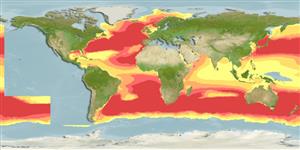Preferred temperature (संदर्भ
123201): 1 - 14.5, mean 7.8 °C (based on 1032 cells).
Phylogenetic diversity index (संदर्भ
82804): PD
50 = 0.8750 [Uniqueness, from 0.5 = low to 2.0 = high].
Bayesian length-weight: a=0.00102 (0.00046 - 0.00225), b=3.06 (2.88 - 3.24), in cm total length, based on all LWR estimates for this body shape (Ref.
93245).
Trophic level (संदर्भ
69278): 3.5 ±0.50 se; based on food items.
लौटाव (संदर्भ
120179): निम्न, न्यूनतम जनसंख्या दुगनी होने का समय 4.5 - 14 वर्ष। (Assuming tmax>10).
Fishing Vulnerability (Ref.
59153): Moderate vulnerability (44 of 100).
🛈
Nutrients (Ref.
124155): Calcium = 26.4 [9.0, 58.4] mg/100g; Iron = 0.303 [0.134, 0.816] mg/100g; Protein = 18 [16, 21] %; Omega3 = 0.176 [0.058, 0.544] g/100g; Selenium = 22.3 [7.8, 62.8] μg/100g; VitaminA = 19.8 [2.3, 158.1] μg/100g; Zinc = 0.516 [0.280, 1.006] mg/100g (wet weight);
